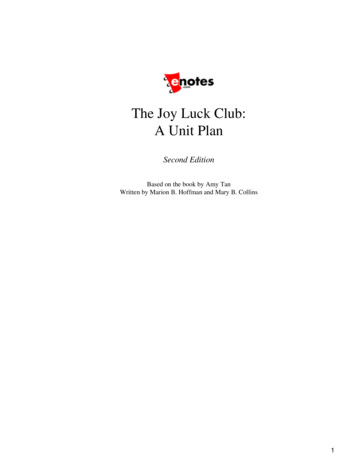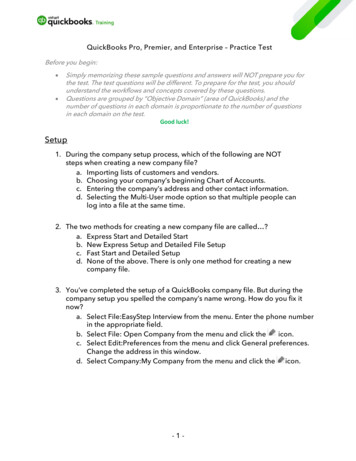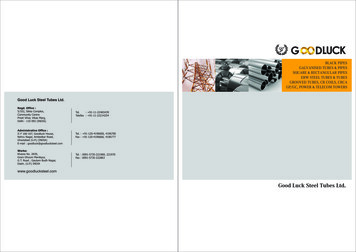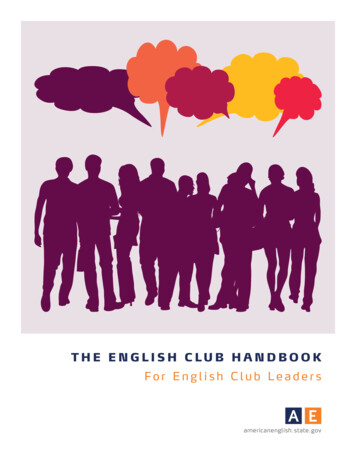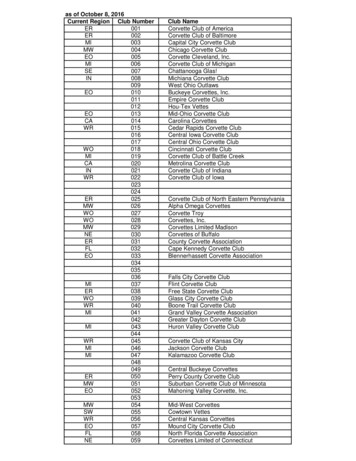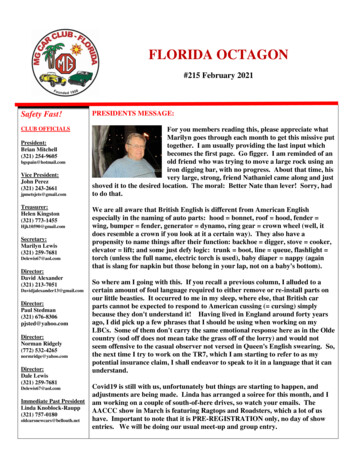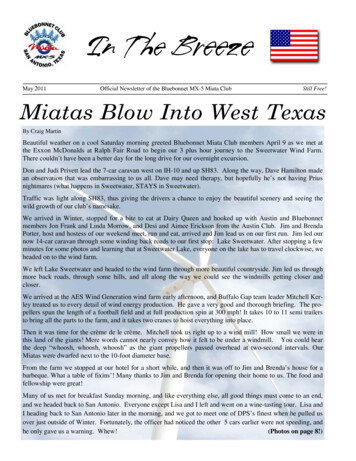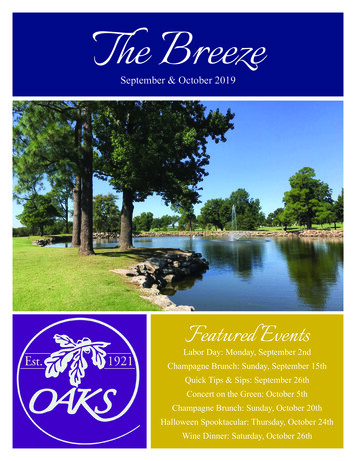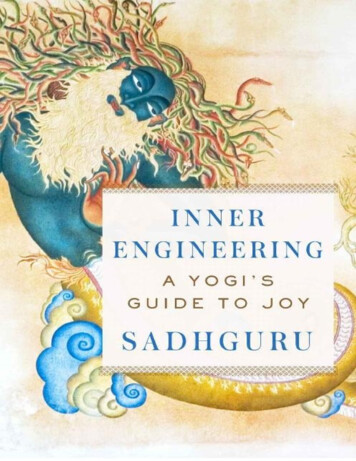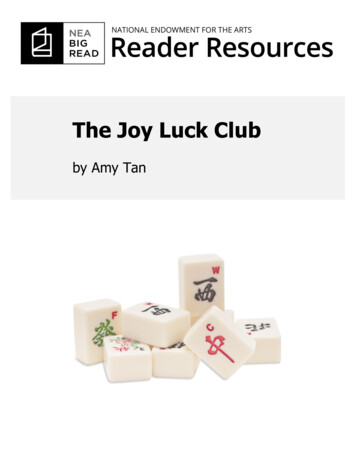
Transcription
The Joy Luck Clubby Amy Tan1
Table of ContentsThe JoyLuck ClubAbout the Book. 3About the Author . 4Historical and Literary Context . 6Other Works/Adaptations . 8Discussion Questions. 9Additional Resources . 10Credits . 11PrefaceAmy Tan's The Joy Luck Club is itself a joyful study in luck.An intricately patterned novel whose author thought she waswriting a short-story collection, it is also a mother-daughtersaga by a writer whose own mother wanted her to beanything but a writer.Published in 1989 by an unknown first-time writer, The JoyLuck Club became a reviewers' darling and then aninternational best seller. The novel tells the story of newwaves of immigrants who are changing and enrichingAmerica.“To me, imaginationis the closest thingwe have tocompassion. Tohave compassionyou have to be ableto imagine the livesof others, includingpeople who aresuffering, andpeople whose livesare affected by us.”What is the NEA Big Read?A program of the National Endowment for the Arts, the BigRead broadens our understanding of our world, ourcommunities, and ourselves through the joy of sharing agood book. Managed by Arts Midwest, this initiative offersgrants to support innovative community reading programsdesigned around a single book.A great book combines enrichment with enchantment. Itawakens our imagination and enlarges our humanity. It canoffer harrowing insights that somehow console and comfortus. Whether you’re a regular reader already or making upfor lost time, thank you for joining the NEA Big Read.NEA Big ReadThe National Endowment for the Arts2
About the BookIntroduction tothe BookMajor Characters in the BookAmy Tan's The Joy Luck Clubwas written as a collection ofshort stories, but the tales ofmemory, fate, and selfdiscovery interlock to create acolorful mural that reads like anovel. All four sections openwith a Chinese fable, then shiftto the stories of four pairs ofmothers and daughters. Thetone switches from mundaneto magical to darkly humorous.The tales, particularly those set in China, are by turnsbeautiful and harrowing.MothersThe first story begins two months after Jing-mei "June" Wooloses her mother, Suyuan, to a brain aneurysm. Hermother's best friends—June's "aunties"—invite June to takeSuyuan's place at their mah jong table so she can sit at theEast, "where everything begins."Suyuan Woo had invented the original Joy Luck Club inChina, before the Japanese invaded the city of Kweilin. Theyhad used the group to help shield themselves from theharshness of war. As they feasted on whatever they couldfind, they transformed their stories of hardship into ones ofgood fortune.Suyuan WooSuyuan's story is told through her daughter. She was forcedto leave her twin babies on the road in China while fleeingthe Japanese invasion.An-mei HsuAt age nine, An-mei joins her widowed mother, who is exiledas a rich man's fourth wife. Her mother commits suicide. Inthe U.S., An-mei questions her faith when her youngest sondrowns.Lindo JongAs a child, Lindo outwits her mother-in-law to escape herarranged marriage. Later, she brags about her Americanborn daughter but also longs for Waverly to notice theirsimilarities.Ying-ying St. ClairWhen her philandering husband dies, Ying-ying leaves herwealthy family and starts over as a shopgirl. She marries anAmerican merchant and emigrates but suffers from episodesof depression as an adult.DaughtersAfter Suyuan reaches the United States, she resurrects theJoy Luck Club with three other Chinese émigrés, and thefour reinvent themselves in San Francisco's Chinatown.These four mothers hope the mix of "Americancircumstances with Chinese character" will give theirdaughters better lives.Jing-mei "June" WooJune is a sensitive child whose mother wants her to becomea piano prodigy. After learning the truth about her mother'spast, she travels to China to find her lost sisters.In each section of the novel, June recounts her late mother'sfantastic tales on evenings after "every bowl had beenwashed and the Formica table had been wiped down twice."Every time Suyuan tells her daughter about Kweilin, sheinvents a new ending. But one night she reveals the realending—how she lost her twin daughters while fleeing theJapanese invasion: "Your father is not my first husband. Youare not those babies."Waverly JongA chess champion as a child, Waverly grows up to become asuccessful tax attorney. She worries about her mother'sopinion of her white fiancé.After her mother's death, June realizes that she had not fullyunderstood her mother's past or her intentions. She journeysto China to discover what her mother had lost there. She isfeverish to find out who she is, where she came from, andwhat future she can create—so she can finally join the JoyLuck Club.NEA Big ReadThe National Endowment for the ArtsRose Hsu JordanTimid Rose is overwhelmed by American choices, but shefinds conviction in the midst of a bewildering divorce.Lena St. ClairGenerous Lena shares her mother's powers of intuition butremains powerless to act on them. The prickly division ofhousehold expenses reveals the impoverishment of hermarriage.3
About the AuthorAmy Tan (b. 1952)Amy Tan was born February 19,1952, in Oakland, California.Her parents shared some of thedark history fictionalized in TheJoy Luck Club. Her mother,Daisy, was born to a wealthyfamily and left Shanghai and adisastrous marriage right beforethe Communist takeover in1949. She was forced to leavebehind her three daughters.Tan's father, John, a BaptistAmy Tan, 2003 (Copyrightminister and electrical engineer,Robert Foothorap)also fled the civil war in China.Tan and her two brothers were raised in Santa Clara,California.Tan was a good student. At age eight, her treatment of thetheme "What the Library Means to Me" won her a transistorradio and mention in the local newspaper. When Tan wasfourteen, her brother Peter and her father died within sevenmonths of each other, both from brain tumors. Aneurosurgeon gave no explanation other than bad luck. Thistwin tragedy spurred Daisy Tan to hoist anchor and movethe family to Switzerland. After they returned to California,Tan was ready for college, where she eschewed hermother's wish for her to study medicine and studiedliterature instead. She met her husband, Lou DeMattei, on ablind date in Oregon while enrolled in one of the sevenundergraduate institutions she attended. Tan followed himto San Jose, California, where she later earned an MA inlinguistics in 1973.While Tan was a doctoral student at the University ofCalifornia, Berkeley, her best friend was murdered. Shockedby the event, Tan left school and started working withchildren as a language development consultant. Her love ofreading reawakened in 1985, when she read many womannovelists for the first time, including Louise Erdrich andMaxine Hong Kingston. Tan settled into a lucrative businesswriting career, but restlessness led her to a writingworkshop. Her second story, "Waiting Between the Trees,"was noticed by a literary agent.Tan started The Joy Luck Club two years after her first tripto China with her mother in 1987, and she completed it inless than five months. The book stayed on the bestseller listfor nine months and has been translated into thirty-sixlanguages. Tan cowrote the screenplay for the 1993 movie,and she and her husband appear in the movie as guests atthe opening dinner party. Besides writing, she toured withNEA Big ReadThe National Endowment for the Artsthe now defunct benefit band the Rock Bottom Remainders,which included fellow writers Stephen King, James McBride,and Matt Groening. Her fifth novel, Saving Fish fromDrowning, was published in 2005.An Interview with Amy TanOn August 7, 2006, Dana Gioia, former Chairman of theNational Endowment for the Arts, interviewed Amy Tan ather home in Berkeley, California. An excerpt from theirconversation follows.Dana Gioia: You were born in Oakland in a family whereboth parents had come from China. Were you raisedbilingually?Amy Tan: Until the age of five, my parents spoke to me inChinese or a combination of Chinese and English, but theydidn't force me to speak Mandarin. In retrospect, this wassad, because they believed that my chance of doing well inAmerica hinged on my fluency in English. Later, as an adult,I wanted to learn Chinese. Now I make an effort when I amwith my sisters, who don't speak English that well. It's sucha wonderful part of me that is coming back, to try and speakthat language.DG: Would you explain the special symbolism of your title,The Joy Luck Club?AT: I don't think joy and luck are specific to Chinese culture.Everybody wants joy and luck, and we all have our differentnotions about from where that luck comes. Many Chinesestores and restaurants have the word "luck" in there. Theidea is that, just by using the word "luck" in names ofthings, you can attract more of it. Our beliefs in luck arerelated to hope. Some people who are without almost anyhope in a situation still cling to luck.DG: This is a great book about the American immigrantexperience. Did you think about that theme consciouslywhen writing the book?AT: If I thought about this at all, it was the immigrantexperience according to my mother and father. Thisinfluenced the way I took their immigrant story-the thingsthat I rejected, the things that I thought were American.The basic notion of this country is that with selfdetermination, you can create who you are. That, in turn,allows an amazing freedom to a writer, because freedom isalso creativity.DG: Why is reading important?AT: In childhood, reading provided a refuge for me,especially during difficult times. It provided me with the ideathat I could find an ending that was different from what was4
happening at the time. Imagination is the closest thing thatwe have to compassion and empathy. When you read aboutthe life of another person, you are part of their life for thatmoment. This is so vital, especially today, when we have somuch misunderstanding across cultures and even within ourown communities.DG: What did you read as a child?AT: I read every fairy tale I could lay my hands on at thepublic library. It was a wonderful world to escape to.DG: Do you feel that your early love of fairy tales expresseditself in The Joy Luck Club, or did you look on its content asrealistic?AT: As a minister, my father told us many stories from theBible that were like fairy tales. Those stories can reflect verystrong beliefs that Christians have, but they also have all thequalities that are wonderful about fairy tales. Life is largerthan we think it is. Certain events can happen that we don'tunderstand, and we can take it as faith in a particular area,or as superstition, or as a fairy tale, or something else. It'swonderful to come to a situation and think that it can be allkinds of possibilities. I look at what's happened to me as apublished writer and, sometimes, I think it's a fairy tale.NEA Big ReadThe National Endowment for the Arts5
Historical and Literary ContextThe Life and Timesof Amy Tan 1977: Mao Zedong's death ends the CulturalRevolution; the "Gang of Four" take the fall for itschaos. 1979: Diplomatic ties established between China andAmerica.1920s1980s 1921: The Chinese Communist Party (CCP) forms. 1928: Chiang Kai-shek unites the Nationalists.1930s 1981: Maya Lin's design for Vietnam VeteransMemorial is chosen by an NEA-funded designcompetition. 1934-35: The Long March helps Mao Zedongconsolidate power. 1987: Bernardo Bertolucci's The Last Emperor, thefirst feature film to show the Forbidden City, wins nineOscars. 1937: Japan launches a full-scale war with China. 1989: The Joy Luck Club is published. 1937: Nanking, the newly established capital of China,falls to Japan on December 13.1990s Breakthrough decade for Chinese-American fiction andmovies. Tan publishes four more books.1940s 1941: Japan bombs Pearl Harbor. China and Americaform an alliance. 1991: Amy Tan's essay "Mother Tongue" is chosen for 1949: The People's Republic of China is established.Daisy Tan boards the last boat out of Shanghai safely. 1993: The Joy Luck Club, cowritten by Amy Tan andRonald Bass, is released as a feature film.1950sBest American Essays.2000s Socialist realism becomes the popular artistic form,deemed most appropriate for the new republic inChina. 2000: Sagwa becomes a PBS cartoon series forchildren, based on Tan's book, Sagwa, The Chinese 1952: Amy Tan is born in Oakland, California. 2005: Tan's fifth novel, Saving Fish from Drowning, ispublished.1960sSiamese Cat. Chairman Mao Zedong launches the CulturalRevolution. Bourgeoisie values and an oldergeneration of artists and intellectuals are attacked andkilled. 1960: Amy Tan wins her first writing contest. 1968: Tan family moves to Montreux, Switzerland.1970s 1972: Nixon is the first U.S. president to visit China. 1975: Maxine Hong Kingston publishes The WomanWarrior.NEA Big ReadThe National Endowment for the Arts6
World War II and San Francisco'sChinatownFrancisco at the start of the Gold Rush. They had formedtight networks and built "Little Shanghai," becauseexclusionary laws made it difficult for Asian immigrants toassimilate or gain citizenship.The WarFor decades the Chinese Exclusion Act of 1882 had limitedimported labor. The World War II alliance between Chinaand the United States became instrumental in repealing thisand other exclusionary laws. The immigrant populationslowly shifted from male sojourners to permanent citizens.The Joy Luck Club is set in two places: China in the 1930sand 1940s and San Francisco's Chinatown from the 1960sthrough the 1980s. Since Chinatown was a haven within anisolated country, the experiences of Tan's fictionalizeddaughters differ sharply from their mothers' generation,which was displaced by war.The turn of the twentieth century hailed massive upheavalsfor China, with the end of the Imperial dynastic system andthe opening of China to global influences. These changes ledto civil wars between the Nationalists and the Communists.The leader of the Nationalist Party, or the Kuomintang, wasChiang Kai-shek, and Mao Tse-tung led the CommunistParty. The Long March, a 6,000-mile-long retreat of the RedArmy in 1934-35, enabled Mao to consolidate his power.(Survivors of the march are heroes to this day.)Even though racial bias persisted in immigration law until atleast 1965, families thrived in Chinatown, with its familiarChinese customs, food, and merchandise. By the 1960sChinatown's seedy intrigue existed only in movies, and itbecame an alluring tourist destination—an exotic island of adifferent culture in the middle of a major American city,complete with temples, fortune cookie factories, and, ofcourse, Chinese restaurants. The famous Chinatown gatewent up in 1970. Nine years later, diplomatic ties werereestablished between the two countries, making it easierfor Chinese-American families to reunite.The Chinese peasantry was lifted by Mao's doctrine, whichencouraged his soldiers to "not take a single needle or apiece of thread from the masses"—masses often terrorizedby the nationalist Kuomintang. The Nationalists, who werearmed with the need to combat Western hegemony, clashedwith the Communists, who were strengthened by theirappeal for the many rural poor.These two groups formed fragile alliances to fight a guerillawar against waves of Japanese invaders in the 1930s.Although few in number, the Japanese gained control ofmajor Chinese cities and coasts.As the United States entered World War II in 1941, themarriage of convenience between the Kuomintang andCommunists against Japan was falling apart. The U.S.backed the Nationalists, although corruption amongKuomintang generals diverted supplies and information tothe Japanese. This corruption and political instability,coupled with the establishment of the People's Republic ofChina in 1949, drove many Chinese to emigrate.The NeighborhoodThese Chinese took the already well-worn route toCalifornia, which to this day retains the largest Chinesepopulation in the United States. The Chinese still refer toSan Francisco as "Old Gold Mountain," because the firstwave of émigrés had come through the Port of SanNEA Big ReadThe National Endowment for the Arts7
Other Works/AdaptationsAmy Tan's Style and Her OtherWorksDaughter (2001), the heroine translates her Alzheimer's-"So easy to read!" was Daisy Tan's reaction to her daughterAmy's stories. Tan's style is deliberately transparent andneat. Her writing captures the different "Englishes" withwhich she grew up-her mother's "broken English," her own"watered-down" translation to English from Chinese, and the"simple" English used by the generations to communicatewith one another. Tan crystallizes these forms to captureChinese imagery and rhythms. She strives to give accuratevoice to the characters, expressing the immigrant experienceby borrowing the unique characteristics of the meldedlanguages. Tan's much-anthologized essay "Mother Tongue"illuminates how she developed this unique writing style.Most of the action in Saving Fish from Drowning (2005)takes place in the present, as twelve American tourists travelto Burma. The narrator, Bibi, is a travel-agent ghost. True toTan's style, the depiction of the characters' lives is deeplyconvincing, as if channeled from the chorus of many ghosts.The themes of The Joy Luck Club include family, heritage,assimilation, and fate. Many of Tan's characters struggle toreconcile American individuality and freedom of choice withChinese wisdom and respect for tradition. Tan excavates thebones of human relationships through singular characters,quick pacing, and sharp storytelling.Tan transforms family history to serve "emotional memory."As depicted in The Joy Luck Club, her grandmother was afourth wife, a concubine who ended her life by swallowingan overdose of opium. Tan's mother was the small child whowitnessed the suicide. Tan has said, "When I place thatmemory in a fictive home, it becomes imagination [.] Ithas the power to change my memory of the way thingsreally happened."The Opposite of Fate: Memories of a Writing Life (2003) is aafflicted mother's journal in an attempt to understand theirshared past.Some of Tan's recent work breaks from the theme ofmothers and daughters, but her gift of storytelling—passedon from her mother—endures. At the peak of her career,Tan's deceptively simple handiwork lasts, ensuring her workwill be shared and enjoyed between new Americangenerations and around the world.Books by Amy Tan The Joy Luck Club, 1989 The Kitchen God's Wife, 1991 The Moon Lady, 1992 Sagwa, The Chinese Siamese Cat, 1994 The Hundred Secret Senses, 1995 The Bonesetter's Daughter, 2001 The Opposite of Fate, 2003 Saving Fish from Drowning, 2005 The Valley of Amazement, 2013collection of essays, speeches, and articles. Here Tan writesthat her mother told her, "For many years, I carried thisshame on my back, and my mother suffered, because shecouldn't say anything to anybody." Tan's joy-luck storiesgrew out of the will to give her mother back her voice.Tan's first four novels feature generations learning tounderstand one another and the clash between cultures. InThe Kitchen God's Wife (1991), Winnie tells her daughterPearl the stories of war-torn China in the 1940s.The Moon Lady (1992) and Sagwa, The Chinese Siamese Cat(1994) are illustrated children's books. The Moon Ladyretells Ying-ying St. Clair's story of the Moon Festival fromThe Joy Luck Club for children. The second book, inspired byTan's favorite cat, was later turned into Sagwa, a children'scartoon series for PBS.Ghosts are a prevalent symbol in Tan's third novel, TheHundred Secret Senses (1995). Olivia, the first-generationAmerican protagonist, meets Kwan, her Chinese step-sister,who can see "yin people"—or ghosts. In The Bonesetter'sNEA Big ReadThe National Endowment for the Arts8
Discussion Questions1.Which story is your favorite and why? Do you preferthe stories set in China or California?2.How are the notions of balance (yin and yang) andenergy flow (feng shui) an important theme in thenovel? Does the Chinese notion of balance and flowtranslate to the characters' lives in America?3.The Joy Luck Club was written as a collection ofshort stories. Is the order important? Could thishave been told as a single story? What would thatchange?4.In your experience, does the book reinforce orshatter stereotypes of Chinese culture?5.By telling a story from the perspective of Chineseimmigrants and first-generation Americans, whatdoes the book reveal about American culture?6.Tan has said that she wishes to break from "theghetto of ethnic literature." Does The Joy Luck Clubcross from the ethnic to the universal?7.Although June is not sure why her mother gives herthe jade necklace, she assumes it's because of herhumiliation by Waverly. Is she right?8.How do the struggles of the daughters mirror thetragedies of their mothers? What does this suggestabout the relationships between parents andchildren?9.Ying-ying sees herself as both a tiger and a ghost.Why does she use these characterizations? Howwould Lena? How would they be different?10. The "broken English" of the mothers is often morecolorful than the "perfect English" of theirdaughters. How does the way the mothers chooseto express themselves reflect their identities? Whatis lost in translation?11. How do the mothers decide to use their mah jongwinnings? Does this show assimilation? Why, or whynot?12. The ritual of mah jong is central to the story. Whatrituals do American women perform that reflectculture and identity?NEA Big ReadThe National Endowment for the Arts9
Additional ResourcesOther Works about Chinese Historyand Culture "Becoming American: The Chinese Experience." ABill Moyers Special from PBS. (Seehttp://www.pbs.org/becomingamerican/ for moreinformation.) Chang, Iris. The Rape of Nanking: The ForgottenHolocaust of World War II. New York: Penguin,1998. Chang, Jung. Wild Swans: Three Daughters ofChina. 1991. New York: Touchstone, 2003. Zee, A. Swallowing Clouds: A Playful JourneyThrough Chinese Culture, Language, and Cuisine.1990. Seattle: University of Washington Press,2002.Websites Amy Tan’s WebsiteAmy Tan's website provides photos, essays, eventsand biographical information.www.AmyTanAuthor.com Guide to the Chinese in California Virtual CollectionAn introduction to San Francisco's Chinatown on theOnline Archive of 5p3019m2 Academy of AchievementAmy Tan's profile on the Academy of doc/page/tan0pro-1If you want to read some of AmyTan's favorite books, you mightenjoy: Charlotte Brontë's Jane Eyre, 1847 J.D. Salinger's The Catcher in the Rye, 1951 Vladimir Nabokov's Lolita, 1955 Gabriel Garcia Marquez's Love in the Time ofCholera, 1988If you want to read books thatinfluenced Amy Tan as a storyteller,you might enjoy: Maxine Hong Kingston's The Woman Warrior:Memoirs of a Girlhood Among Ghosts, 1975 Louise Erdich's Love Medicine, 1984 Isabel Allende's The House of the Spirits, 1985NEA Big ReadThe National Endowment for the Arts10
CreditsWorks CitedExcerpts from THE JOY LUCK CLUB by Amy Tan, copyright 1989. Used by permission of G.P. Putnam's Sons, adivision of Penguin Group (USA) Inc.Tan, Amy. Interview. Salon. 12 November ---. The Opposite of Fate: Memories of a Writing Life. NewYork, Penguin, 2003.AcknowledgmentsThe National Endowment for the Arts was established byCongress in 1965 as an independent agency of the federalgovernment. To date, the NEA has awarded more than 5billion to support artistic excellence, creativity, andinnovation for the benefit of individuals and communities.The NEA extends its work through partnerships with statearts agencies, local leaders, other federal agencies, and thephilanthropic sector.Writers: Maryrose Flanigan for the National Endowment forthe ArtsCover image: "Studio shot of Mahjong pieces on whitebackground" by Lars Hallstrom. Shutterstock.Arts Midwest promotes creativity, nurtures culturalleadership, and engages people in meaningful artsexperiences, bringing vitality to Midwest communities andenriching people’s lives. Based in Minneapolis, Arts Midwestconnects the arts to audiences throughout the nine-stateregion of Illinois, Indiana, Iowa, Michigan, Minnesota, NorthDakota, Ohio, South Dakota, and Wisconsin. One of six nonprofit regional arts organizations in the United States, ArtsMidwest’s history spans more than 30 years.The NEA Big Read Reader Resources are licensed under a CreativeCommons Attribution-NonCommercial-NoDerivatives 4.0 InternationalLicense. Arts MidwestNEA Big ReadThe National Endowment for the Arts11
NEA Big Read The National Endowment for the Arts 3 Introduction to the Book Amy Tan's The Joy Luck Club was written as a collection of short stories, but the tales of memory, fate, and self-discovery interlock to create a colorful mural that reads like a novel. All four sections open with a Chinese fable, then shiftFile Size: 490KB
